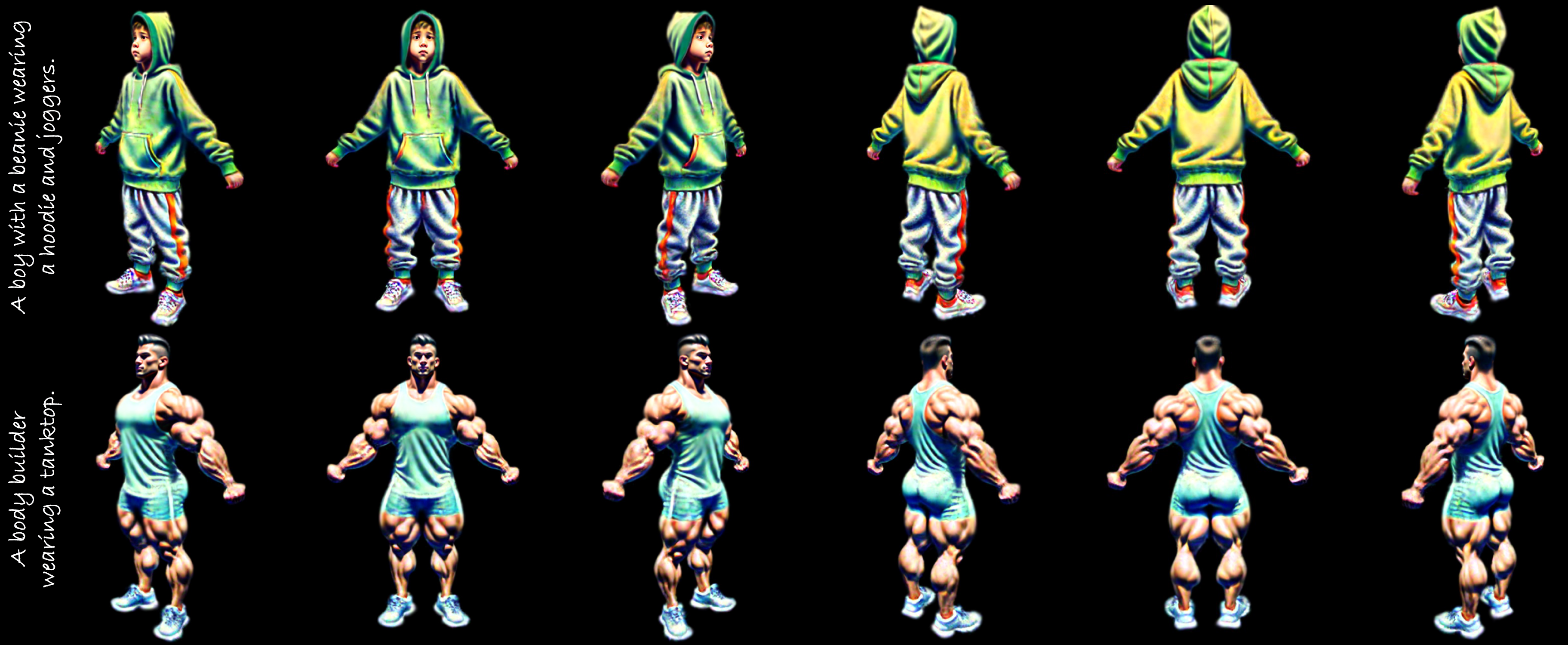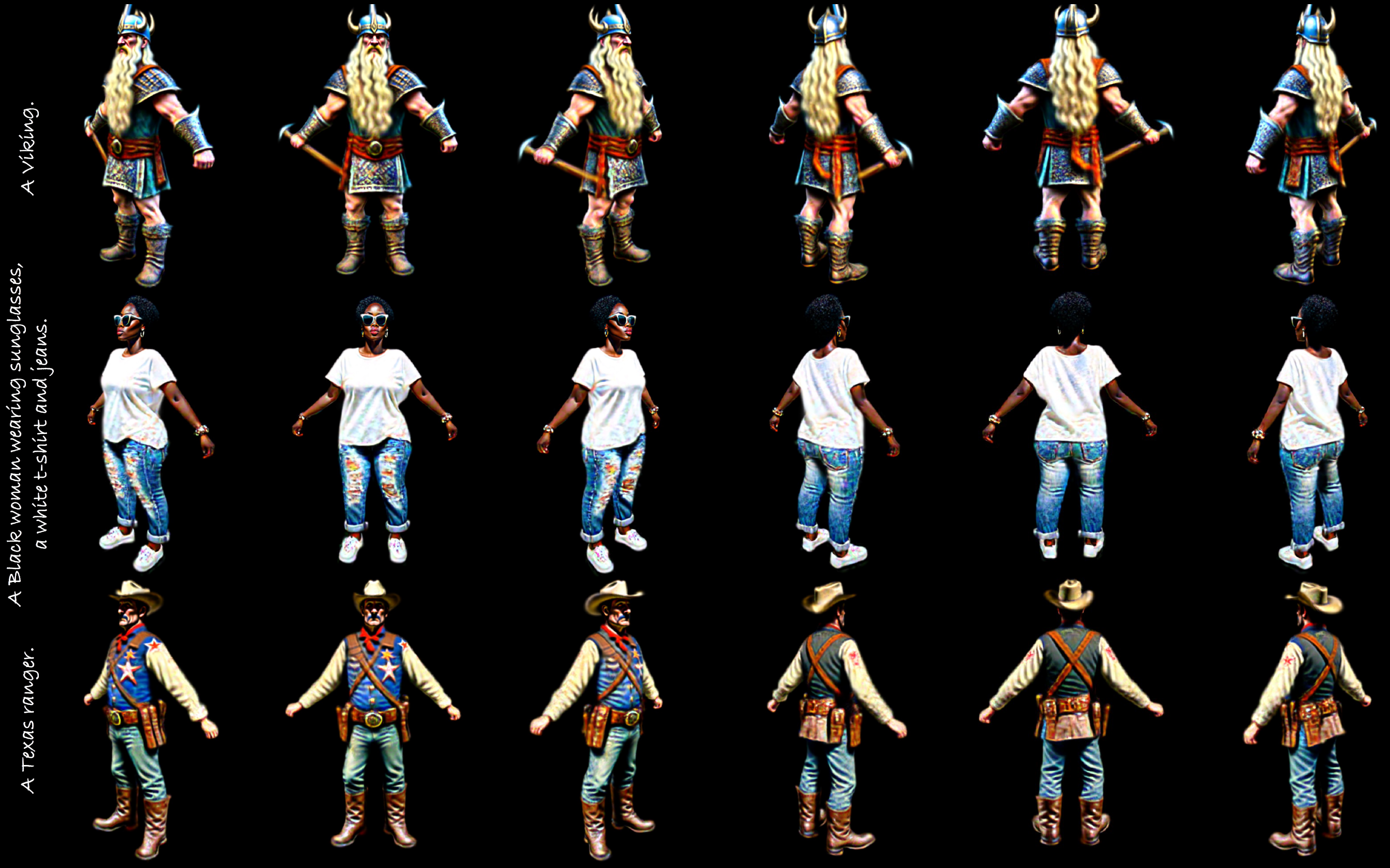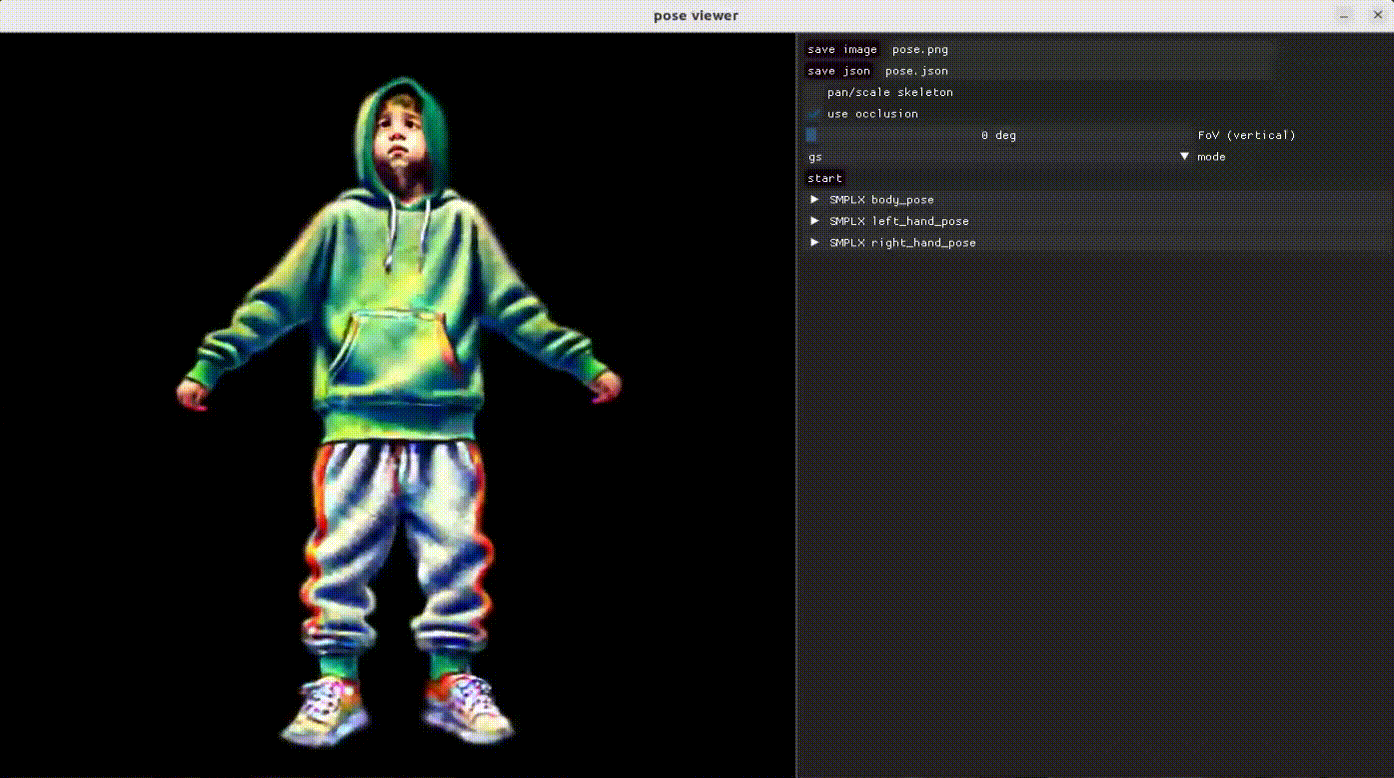Xian Liu1, Xiaohang Zhan2, Jiaxiang Tang3, Ying Shan2, Gang Zeng3,
Dahua Lin1, Xihui Liu4, Ziwei Liu5.
1CUHK 2Tencent AI Lab 3PKU 4HKU 5NTU
Realistic 3D human generation from text prompts is a desirable yet challenging task. Existing methods optimize 3D representations like mesh or neural fields via score distillation sampling (SDS), which suffers from inadequate fine details or excessive training time. In this paper, we propose an efficient yet effective framework, HumanGaussian, that generates high-quality 3D humans with fine-grained geometry and realistic appearance. Our key insight is that 3D Gaussian Splatting is an efficient renderer with periodic Gaussian shrinkage or growing, where such adaptive density control can be naturally guided by intrinsic human structures. Specifically, 1) we first propose a Structure-Aware SDS that simultaneously optimizes human appearance and geometry. The multi-modal score function from both RGB and depth space is leveraged to distill the Gaussian densification and pruning process. 2) Moreover, we devise an Annealed Negative Prompt Guidance by decomposing SDS into a noisier generative score and a cleaner classifier score, which well addresses the over-saturation issue. The floating artifacts are further eliminated based on Gaussian size in a prune-only phase to enhance generation smoothness. Extensive experiments demonstrate the superior efficiency and competitive quality of our framework, rendering vivid 3D humans under diverse scenarios.
-
[2023-12-05] Update the real-time animation demo and codes!
-
[2023-11-28] Upload the paper. Release all the training codes and pretrained models!
# clone the github repo
git clone https://github.com/alvinliu0/HumanGaussian.git
cd HumanGaussian
pip install torch==2.0.1+cu118 torchvision==0.15.2+cu118 torchaudio==2.0.2 --index-url https://download.pytorch.org/whl/cu118
pip install -r requirements.txt
# a modified gaussian splatting (+ depth, alpha rendering)
git clone --recursive https://github.com/ashawkey/diff-gaussian-rasterization
pip install ./diff-gaussian-rasterization
The text prompts that are used for qualitative/ablation visual results demonstration are included in prompts_gallery.txt.
We recommend you to prepare below pre-trained models before the training process:
-
SMPL-X. Please kindly refer to the SMPL-X project page for the download instructions;
-
Texture-Structure Joint Model, which is trained on the text-image-depth pairs annotated by MiDaS on the LAION dataset.
After downloading the above models, you could specify the path to SMPL-X model in system.smplx_path, and the path to Texture-Structure Joint Model in system.guidance.model_key of the config file.
If you want to run the inference/rendering based on the pretrained 3DGS avatars, you could download all the related avatar .ply files in:
- Human Ply Files Gallery, which contains all the pre-trained 3DGS avatars shown in qualitative/ablation visual results demonstration included in
prompts_gallery.txt.
python launch.py --config configs/test.yaml --train --gpu 0 system.prompt_processor.prompt="A boy with a beanie wearing a hoodie and joggers"
python launch.py --config configs/test.yaml --train --gpu 1 system.prompt_processor.prompt="A buddha"
python launch.py --config configs/test.yaml --train --gpu 2 system.prompt_processor.prompt="A sexy teenage girl in a bikini"
python launch.py --config configs/test.yaml --train --gpu 3 system.prompt_processor.prompt="A Western cowboy smoking a cigarette"
python launch.py --config configs/test.yaml --train --gpu 4 system.prompt_processor.prompt="A girl who looks like a pig"
python launch.py --config configs/test.yaml --train --gpu 5 system.prompt_processor.prompt="a woman wearing a short jean skirt, a cropped top, and a white sneaker"
python launch.py --config configs/test.yaml --train --gpu 6 system.prompt_processor.prompt="Donald Trump"
python launch.py --config configs/test.yaml --train --gpu 7 system.prompt_processor.prompt="A man in big shorts and a white vest"python launch.py --config configs/anydoor_test.yaml --train --gpu 3 system.prompt_processor.prompt="A_man_in_big_shorts_and_a_white_vest"Though the HumanGaussian framework is trained on a single body pose at the training stage, it can be animated with unseen pose sequences in a zero-shot manner, i.e., we can use a sequence of SMPL-X pose parameters to animate the pre-trained avatars w/o further finetuning.
We rely on some extra dependencies:
# for GUI
pip install dearpygui
# cubvh
pip install git+https://github.com/ashawkey/cubvh
# a modified gaussian splatting (+ depth, alpha rendering)
git clone --recursive https://github.com/ashawkey/diff-gaussian-rasterization
pip install ./diff-gaussian-rasterization
# nvdiffrast
pip install git+https://github.com/NVlabs/nvdiffrast/
# kiuikit
pip install -U git+https://github.com/ashawkey/kiuikit
# smplx
pip install smplx[all]
# please also download SMPL-X files to ./smplx_models/smplx/*.pklGaussian files are generated by HumanGaussian and saved as ply files. Motions should follow the SMPL-X body pose format (21 joints), which could read by:
motion = np.load('content/amass_test_17.npz')['poses'][:, 1:22, :3]
# motion = np.load('content/Aeroplane_FW_part9.npz')['poses'][:, 1:22, :3]Then, perform the zero-shot animating by:
# visualize in gui
python animation.py --ply <path/to/ply> --motion <path/to/motion> --gui
# play motion and save to videos/xxx.mp4
python animation.py --ply <path/to/ply> --motion <path/to/motion> --play
# also self-rotate during playing
python animation.py --ply <path/to/ply> --motion <path/to/motion> --play --rotateFor example, you can animate the "A boy with a beanie wearing a hoodie and joggers" avatar with some sample motions as:
# play motion and save to .mp4 for "A boy with a beanie wearing a hoodie and joggers" case
python animation.py --ply "content/sample.ply" --motion "content/Aeroplane_FW_part9.npz" --play
python animation.py --ply "/mnt/disk_1/yixuan/HumanGaussianData/output/test2/An_old_lady_in_a_green_beret_in_a_cotton_coat_and_a_floral_skirt_with_purple_heels@20231216-000452/save/oldlady.ply" --motion "content/Aeroplane_FW_part9.npz" --playThis work is built on many amazing research works and open-source projects, including Threestudio, 3DGS, diff-gaussian-rasterization, GaussianDreamer. Thanks a lot to all the authors for sharing!
-
We train on the resolution of 1024x1024 with a batch size of 8. The whole optimization process takes one hour on a single NVIDIA A100 (40GB) GPU. We recommend to use a smaller batch size if you want to decrease the training time or GPU memory cost.
-
There is a minor difference between the main paper and code implementation. In the main paper, we use an annealed negative prompt guidance to gradually drop the weight of negative score. In practice, we empirically find that a similar approach proposed in a concurrent work NFSD to turn off the negative score at small timesteps yields slightly stabler optimization. You are free to switch between two variants by using the timestep-conditioned binary mask or a dropping weighting term in L385 of the
threestudio/models/guidance/dual_branch_guidance.py.
If you find this repository/work helpful in your research, welcome to cite the paper and give a star.
@article{liu2023humangaussian,
title={HumanGaussian: Text-Driven 3D Human Generation with Gaussian Splatting},
author={Liu, Xian and Zhan, Xiaohang and Tang, Jiaxiang and Shan, Ying and Zeng, Gang and Lin, Dahua and Liu, Xihui and Liu, Ziwei},
journal={arXiv preprint arXiv:2311.17061},
year={2023}
}
Besides, since the idea of simultaneously denoising RGB and depth for joint distribution learning is largely inspired by the work HyperHuman, please also kindly cite the paper if you find it helpful or use the pretrained model for SDS:
@article{liu2023hyperhuman,
title={HyperHuman: Hyper-Realistic Human Generation with Latent Structural Diffusion},
author={Liu, Xian and Ren, Jian and Siarohin, Aliaksandr and Skorokhodov, Ivan and Li, Yanyu and Lin, Dahua and Liu, Xihui and Liu, Ziwei and Tulyakov, Sergey},
journal={arXiv preprint arXiv:2310.08579},
year={2023}
}




